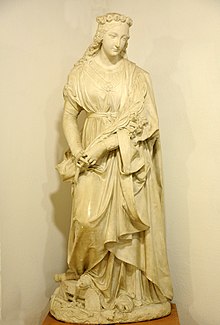Johann Dominik Mahlknecht

Johann Dominik Mahlknecht (* 1793 in Überwasser in Ortisei in Val Gardena , municipality of Castelrotto , † 1876 in Paris ) was a French sculptor of Tyrolean origin. In France it is mainly known under the name Dominig or Dominique Molknecht, Molchneht or Molchnecht .
biography
Johann Dominik Mahlknecht emigrated to France at a young age, where he was named one of the most important sculptors of his time and finally a "state artist". Mahlknecht died in Paris in 1876.
It is falsely claimed that Mahlknecht was a student of Canova . In 1810 he emigrated to France in the service of the Black Forest trader Andre Mölzer. Temporary admission to the Sanoner family of Val Gardena in Lyon and also financially supported by them, he moved to Le Mans for seven months , where a fellow countryman who was not known by name trained him further. From 1812 Mahlknecht settled in Nantes . He probably worked there in the workshop of Joseph Debay (1779–1863) and became an independent and well-known artist at the age of 20. In 1826 Mahlknecht was appointed “His Royal Highness Sculptor” and the Ministry of the Interior made available to him a studio at Quai D'Orsay No. 9 in Paris. Two of his most famous students were Amédée René Ménard and Jean-Baptiste Barré .
In 1840, the French state commissioned 33 different artists to create the 33 larger-than-life statues that adorn the outer walls of the La Madeleine church (Paris), alternating with the 52 columns of the peristilium. This variety of styles by well-known artists and the succession of male and female saints prepares the visitor for the monumental character of the church interior. Mahlknecht created St. Francis de Sales, who stands on the right outer wall of the church, as the eighth saint, between the saints Adelheid and Helene.
In 1859 a critic of the Bothen for Tyrol and Vorarlberg wrote to the Terpsichore Mahlknecht: “If a Greek came over from ancient times, he would probably not recognize a Terpsichore in the Malknecht statue, and would only be able to form a judgment if he came to Paris and seen a ballet in Paris. For a muse it is too ignoble, too passionate and too expressionless ... Mahlknecht did not study his Terpsichore in antiquity, but adapted it entirely to the sensualistic tastes of modern Parisians. It is this superficiality of conception that we must disapprove of, without doubting the artist's significant talents; we must even, to be fair, acknowledge that this statue was made with an expenditure of artistic ability and skill which would be worth a nobler cause ”(Bothe for Tyrol and Vorarlberg 124 (1859) 536).
Other works
- Saint Philomena , marble 165 cm. Paris, Eglise Saint Germain-l'Auxerrois
- Statues of the evangelists that JD Mahlknecht donated to the parish church of Ortisei in Val Gardena in his birthplace around 1859 .

literature
- Constantin von Wurzbach : Mahlknecht, also Mallknecht, Dominik . In: Biographisches Lexikon des Kaiserthums Oesterreich . 16th part. Kaiserlich-Königliche Hof- und Staatsdruckerei, Vienna 1867, pp. 278–282 ( digitized version ).
- Rudolf Müller: Mahlknecht, Dominik . In: Allgemeine Deutsche Biographie (ADB). Volume 20, Duncker & Humblot, Leipzig 1884, pp. 94-96.
- Egg: Mahlknecht Johann Dominik. In: Austrian Biographical Lexicon 1815–1950 (ÖBL). Volume 5, Verlag der Österreichischen Akademie der Wissenschaften, Vienna 1972, p. 413.
- Eugen Trapp: Dominik Mahlknecht 1793–1876. A Val Gardena as a French state artist. Monograph and critical catalog . Publisher: Istitut Ladin Micura de Rü, San Martin de Tor 1991.
- François Pupil: Eglise de la Madeleine. L'histoire d'une paroisse . Paroisse de la Madeleine, Paris 2000.
Web links
- Literature by and about Johann Dominik Mahlknecht in the catalog of the German National Library
- Johann Dominik Mahlknecht in the Tyrolean State Museum Ferdinandeum
- Catalog of 43 works by the artist in the Archives Nationales - accessed on August 26, 2011
Individual evidence
- ↑ Ellen Hastaba: Program with coincidence and flaws - all-Tyrolean: the facade of the Tyrolean Provincial Museum Ferdinandeum. In: Publications of the Tiroler Landesmuseum Ferdinandeum, Volume 83 (2003), pp. 63–94 ( PDF; 224 kB )
| personal data | |
|---|---|
| SURNAME | Mahlknecht, Johann Dominik |
| ALTERNATIVE NAMES | Molknecht; Newts; Dominig; Dominique |
| BRIEF DESCRIPTION | French sculptor |
| DATE OF BIRTH | 1793 |
| PLACE OF BIRTH | Overwater near Ortisei in Val Gardena |
| DATE OF DEATH | 1876 |
| Place of death | Paris |






